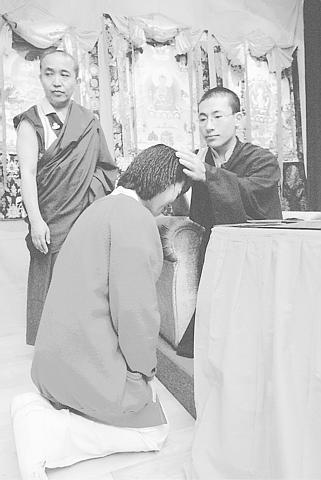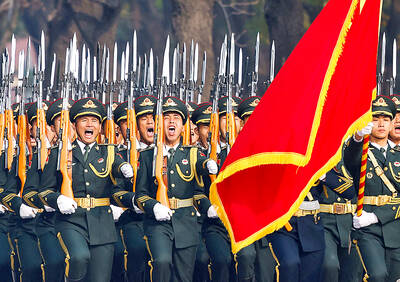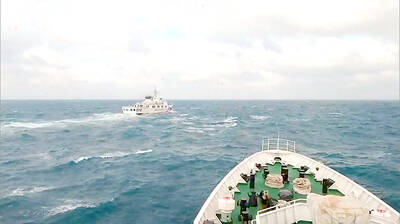Two groups of Tibetan Buddhist masters visited Taiwan last week to bless victims of the 921 earthquake.
They came for the same purpose, arrived on the same day and had devoted followers receive them at the airport last Saturday.
Most importantly, both claimed to be the real religious king of the Karma Kagyu Tibetan Buddhist sect.

PHOTO: CHEN CHENG-CHANG, TAIPEI TIMES
And with the involvement of local politicians in the controversy over who is the rightful leader of the sect, a controversy over the kings -- also called "Karmapa" (大寶法王) -- that has raged for more than a decade has arrived in Taiwan.
The two Karmapas, one recognized both by the Dalai Lama and the Chinese Government, and the other recognized by the Dalai Lama's chief disciple, are believed by their respective followers to be reincarnation of Rangjung Rigpe Dorje, the last Karmapa of the sect who died in 1981.
Karma Kagyu, also called the "white sect," is one of the four schools in Tibetan Buddhism. It relies on reincarnation to determine its religious leader.
The controversy started 10 years after the 16th Karmapa died. Two of his disciples claimed to have found the reincarnation of their master, one in Tibet and the other in Bhutan.
Thinley Thaye Dorje, 17, is the Bhutanese incarnation, and was recognized by the Karmapa's chief disciple Sharmapa Rinpoche in 1992.
According to Lopon Rinpoche, abbot of the Karma Kagyu Temple in Tainan who organized the Bhutanese Karmapa's visit to Taiwan, the purpose of Thinley Thaye Dorje's visit was to both bless earthquake victims and to conduct an inauguration ceremony for the Tainan temple later this week.
The Tibetan Karmapa, 14-year-old Urgyn Trinley Dorje, sent his disciple Tai Sitypa Rinpoche to conduct blessing ceremonies in Taiwan after hearing of the damage wrought by the earthquake, according to the Huayu Foundation (化育基金會), founded by former Control Yuan President Chen Li-an (陳履安), which organized the master's trip.
The two groups took different routes after arriving in Taiwan.
The representative of the Tibetan branch conducted two relief ceremonies in Changhwa County, while the Bhutanese Karmapa met local officials and conducted two relief ceremonies in Taipei.
The Bhutanese Karmapa was welcomed by Minister of the Interior Huang Chu-wen (黃主文) and legislative speaker Wang Jin-pyng (王金平). He also donated a sum of NT$5 million for quake relief and reconstruction work.
Politics have always been involved in the contentious debate over the Karmapas.
Followers of the Bhutanese Karmapa say that China's recognition of the 17th Karmapa was politically motivated.
"We [Karma Kagyu] don't need recognition from political organizations, nor recognition from outside our sect [meaning from the Dalai Lama]," claimed Sharmapa Rinpoche, Thaye Dorje's chief disciple.
Lopon Rinpoche, a locally-based lama who invited Thaye Dorje to visit, also commented that there was political involvement in the visit of the Tibetan-backed Karmapa.
Of course, the political speculation was denied by those who followed the Tibetan branch.
"It's not true. Politicians have no authority to recognize our religious leader," said Tenam Lama, secretary of Tai Situpa Rinpoche.
"I feel sad for them, but we'll pray for them," he said.
According to Tenam Lama, 95 percent of Tibet's residents believe that Urgyn Trinley Dorje is the real incarnation of the 17th Karmapa.
This claim was backed by religious scholar Chiang Tsan-teng (江燦騰) from Taiwan's National Tsinghua University.
Ironically, Taiwanese politicians exacerbated the political divide even before the masters arrived.
At the end of last month, KMT legislator Cheng Yung-chin (鄭永金) led 51 legislators, including speaker Wang, in demanding that the Cabinet-level Mongolian and Tibetan Affairs Commission (蒙藏委員會) approve the Bhutanese candidate's visit and allow only him to use the title of Karmapa.
They also asked the Police Administration to provide favorable entry visas for his entourage and a motorcade during his visit.
This move immediately aroused protest from supporters of the Tibet-based Karmapa.
The Huayu Foundation and the Chinese Karma Kagyu Association wrote to the Presidential Office, the Executive Yuan, the Ministry of Foreign Affairs and the Ministry of the Interior, claiming the Bhutanese Karmapa was a fake and should not be allowed entry to Taiwan.
Chen, a long-time follower of the Tsurphu Temple (楚布寺) in Lhasa, Tibet, said the recognition of the Tibetan Karmapa had conformed to the lineage convention of Kama Kagyu.
"There has always been only one Karmapa in the history of Kama Kagyu, and it is impossible to have other incarnations of him living at the same time. This can be found from the historical records and lineage conventions of Kama Kagyu," Chen said.
New Party legislator Hsieh Chi-ta (謝啟大) also demanded organizers not use the name of Karmapa to promote the Bhutanese Karmapa.
"I hope this event will not turn into a political struggle in Taiwan," Hsieh said.
According to Cheng, Lopon Rinpoche, the abbot of Tainan Kama Kagyu Temple, contacted his staff in March this year for help in organizing the visit of the Bhutanese Karmapa. He said he thought the visit would be beneficial and promised to help.
In an attempt to end the fight, Kao Kung-lien (高孔廉), chairman of the Cabinet-level Mongolian and Tibetan Affairs Commission, then ordered both sides not use the name Karmapa in promoting their activities. If they failed to comply, the commission said it would deny entry of Tibetan monks to Taiwan in the future.
"Taiwanese politicians like to be associated with religious leaders and sometimes use them as campaign tools," said Chiang.
"The question of who is the real Karmapa only makes sense to those who are willing to practice Buddhism. Getting too obsessed with comparison and contention only brings us trouble and obstacles to the practice," said Chen Yu-ting (陳宇廷), Chen's oldest son and the director of the Huayu Foundation.
Please see tomorrow's edition for a report on the growing popularity of Tibetan Buddhism in Taiwan.

Conflict with Taiwan could leave China with “massive economic disruption, catastrophic military losses, significant social unrest, and devastating sanctions,” a US think tank said in a report released on Monday. The German Marshall Fund released a report titled If China Attacks Taiwan: The Consequences for China of “Minor Conflict” and “Major War” Scenarios. The report details the “massive” economic, military, social and international costs to China in the event of a minor conflict or major war with Taiwan, estimating that the Chinese People’s Liberation Army (PLA) could sustain losses of more than half of its active-duty ground forces, including 100,000 troops. Understanding Chinese

The Ministry of Foreign Affairs (MOFA) yesterday said it is closely monitoring developments in Venezuela, and would continue to cooperate with democratic allies and work together for regional and global security, stability, and prosperity. The remarks came after the US on Saturday launched a series of airstrikes in Venezuela and kidnapped Venezuelan President Nicolas Maduro, who was later flown to New York along with his wife. The pair face US charges related to drug trafficking and alleged cooperation with gangs designated as terrorist organizations. Maduro has denied the allegations. The ministry said that it is closely monitoring the political and economic situation

UNRELENTING: China attempted cyberattacks on Taiwan’s critical infrastructure 2.63 million times per day last year, up from 1.23 million in 2023, the NSB said China’s cyberarmy has long engaged in cyberattacks against Taiwan’s critical infrastructure, employing diverse and evolving tactics, the National Security Bureau (NSB) said yesterday, adding that cyberattacks on critical energy infrastructure last year increased 10-fold compared with the previous year. The NSB yesterday released a report titled Analysis on China’s Cyber Threats to Taiwan’s Critical Infrastructure in 2025, outlining the number of cyberattacks, major tactics and hacker groups. Taiwan’s national intelligence community identified a large number of cybersecurity incidents last year, the bureau said in a statement. China’s cyberarmy last year launched an average of 2.63 million intrusion attempts per day targeting Taiwan’s critical

‘SLICING METHOD’: In the event of a blockade, the China Coast Guard would intercept Taiwanese ships while its navy would seek to deter foreign intervention China’s military drills around Taiwan this week signaled potential strategies to cut the nation off from energy supplies and foreign military assistance, a US think tank report said. The Chinese People’s Liberation Army (PLA) conducted what it called “Justice Mission 2025” exercises from Monday to Tuesday in five maritime zones and airspace around Taiwan, calling them a warning to “Taiwanese independence” forces. In a report released on Wednesday, the Institute for the Study of War said the exercises effectively simulated blocking shipping routes to major port cities, including Kaohsiung, Keelung and Hualien. Taiwan would be highly vulnerable under such a blockade, because it